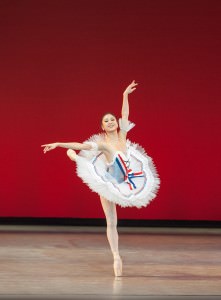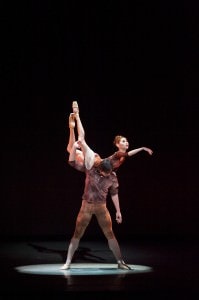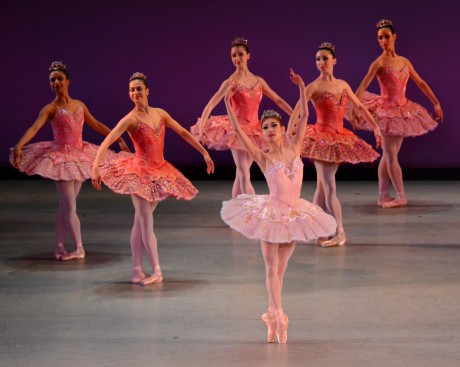The Washington Ballet: Tour-de-Force: Balanchine is a truly spectacular evening at the ballet, with something for everyone. This program has, in my opinion, a balance of classical and contemporary ballet works that will keep any audience member engaged and excited throughout the performance. The first act of the performance consisted of classical and contemporary pas de deux (dance for two), as well as a couple pas de quatre (dance for four). The choreographers of this act range from household names in the world of ballet, to ballet figures near and dear to The Washington Ballet, to Artistic Director Septime Webre.

Flames of Paris, choreographed by Vasili Vainonen, set to music by Boris Asafyev and performed by Tamako Miyazaki and Chong Sun, was the first piece of the evening. Miyazaki and Sun were clad in grey and white ensembles, with ribbons of red, white and blue adorning her tutu and his top. Miyazaki’s precision throughout the pas was spot on, and her strength, especially during a sequence where she hopped en pointe along the diagonal of the stage, was truly breathtaking to behold. Sun is the epitome of strength, both in his support of Miyazaki and his performance on his own. This is the perfect piece to open the performance, as it is sure to engage the audience from the first chord of music, which is particularly rousing and dynamic.
Momentum (Pas de Deux), choreographed by Choo San Goh, set to music by Sergei Prokofiev and performed by Kateryna Derechyna and Tamás Krizsa, was the next piece in the program. Choo San Goh, former Associate Director of The Washington Ballet, explores a hauntingly beautiful relationship between two bodies in space. Derechyna and Krizsa, in black and white unitards, exhibit perfect synchronicity, and at times are so perfectly poised that they appear as one moving body. The ethereal nature of this piece is soothing, as well as the silky smooth movement quality embraced in the same way by both dancers.
As Above, So Below (Pas de Deux), choreographed by Edwaard Liang, set to music by Johann Sebastian Bach and Alessandro Marcello, performed by Sona Kharatian and Luis R. Torres was the next piece performed. Liang, whose works have been previously performed by the company, has danced for both New York City Ballet as well as Nederlands Dans Theater, under the direction of Jirí Kylián. These artistic influences are ever present in Liang’s work. Kharatian and Torres perform with a raw sensuality; Torres dancing in black pants with a bare chest and Kharatian dancing in a little white shift dress. The piece is beautifully playful, and seems to be all about power. Who has the power, and what does the other person do to take the power from the one in control? Kharatian and Torres give and take in this duet with stellar synchronicity, and perform with a very on edge quality that is palpable from the audience.
D-Construction, choreographed by Artistic Director Septime Webre, set to music by John Cage and performed by Jared Nelson, Andile Ndlovu, Corey Landolt, and Daniel Roberge, is one of the most exciting works on the program. As a means of celebrating his twenty-fifth year as a choreographer, Webre has reset the first piece of choreography he ever created. This work displays Webre’s gifts as a choreographer, namely seamlessly transitioning dancers into and out of various permutations onstage, his ability to create movement that defies the audience’s ideas of what the human body is capable of, and his knack for musicality. Nelson, Ndlovu, Landolt and Roberge display extraordinary ability to perform in perfect unison, as well as shine in solo moments. This pas de quatre of gentlemen, in black tank tops and shorts, embody a fierce athletic prowess, with grand leaps and multiple beats of the feet while quickly jumping through the space.
Sympathique, choreographed by Artistic Director Septime Webre, set to music by Pink Martini, and performed by Fernanda Oliveira, Josue Jústiz, Daniel Savetta, and Marshall Whiteley, perfectly juxtaposes Webre’s first choreographic work. With this piece, Webre exhibits a gift for entertaining an audience. On the surface, Sympathique is a light and bubbly pas de quatre in the style of old Hollywood. When you delve deeper into this work, however, Webre displays a keen eye for awe-inspiring partnering, seamless transitions, and visually interesting lines of the body. Oliveira is a commanding presence in this work, in a gorgeous white dress. Through each and every lift, toss, and leap of her body she is in control, is perfectly poised, and has a smile on her face that lets the entire audience know she was born to perform. Jústiz, Savetta, and Whiteley’s strength, performance quality, and effortless athleticism allow this piece to pop with pizzazz.
Opposites Attract, choreographed by Elaine Kudo (The Washington Ballet’s Ballet Master), set to music by Ottmar Leibert, and performed by Morgann Rose, Luis R. Torres, Aurora Dickie, and Zachary Hackstock, followed in the program. Kudo’s work is fun and flirty, with a beautifully dynamic musical score. At the top of the piece, the pas the quatre is paired off according to costume colors, with a pas de deux in shades of blue and green, and another pas de deux in shades of red and purple. As the piece unfolds, the adroit and dynamic Rose, Torres, Dickie and Hackstock experience perfectly nice movement qualities with their like pair. As they let go, and allow themselves to branch out, the male and female of different costume pairs find an organic, exciting and wholly different movement quality and relationship with the dancer of the opposite costume colors. This piece is both audience-friendly to analyze and wonderful to experience on the surface.

Together Apart (World Premiere), choreographed by Tamas Krizsa, set to music by Blake Neely, and performed by Maki Onuki and Tamás Krizsa, is the work of company dancer Krizsa. Krizsa’s pas de deux is a wonderfully soothing experience, with punctuated moments of differing dynamics that keep the audience alert. The partnering in this work is eerily seamless. Onuki and Krizsa perform with crisp precision, in brown and beige bodysuits.
Diana and Acteon (Pas de Deux), choreographed by Marius Petipa, set to music by Cesare Pugni, and performed by Ayano Kimura and Brooklyn Mack, was the last piece before the Intermission. Petipa’s classical choreography shines in the uniquely athletic and graceful bodies of Kimura and Mack. The competitive, physical tête-à-tête between both dancers is stunning to behold, what with Kimura’s ability to slice through the space, turning and leaping, and Mack’s extraordinary athleticism and efficient spatial patterns. The resounding audience response to both dancer’s variations and the coda speak to the powerful performances of Kimura and Mack.
The final piece of the evening, George Balanchine’s Theme and Variations, set to the music of Pyotr Ilyich Tchaikovsky, allows The Washington Ballet’s dancers to shine, in this intricate and dynamic piece. From the rise of the curtain, the audience applauded vigorously, due to the sheer beauty of the opening stage picture; the female and male Principal dancers (Maki Onuki and Jonathan Jordan, respectively), perfectly framed by the Soloist women (Sona Kharatian, Aurora Dickie, Kateryna Derechyna, and Morgann Rose) and the Corps women (Ayano Kimura, Fernanda Oliveira, Esmiana Jani, Francesca Dugarte, Carly Wheaton, Laura Chachich, Sukyung Park, and Tamako Miyazaki), and a number of chandeliers hung from the ceiling, against a purple, grey and blue backdrop. Balanchine’s homage to the Russian ballet, at a time when Tchaikovsky’s music elevated the art form to magnificent heights, still thrills and excites audiences to this day. Onuki and Jordan command attention and have similarly regal movement qualities to their dancing. The beauty of the piece is that the audience understands the hierarchy of the ballet as it unfolds before their eyes. The principal man and woman do the majority of the dancing at the top of the work, with the soloist women dancing here and there, and the corps dancing every so often. With each new variation, the hierarchy is broken down a bit, and the soloists and corps become more integral to the performance. After a beautiful pas de deux between Onuki and Jordan, the cast enters the stage space in droves, and introduces the soloist men (Jared Nelson, Brooklyn Mack, Corey Landolt, and Chong Sun) and the corps men (Andile Ndlovu, Daniel Roberge, Zachary Hackstock, Luis R. Torres, Marshall Whiteley, Josue Jústiz, Daniel Savetta, Ariel Breitman). By the end of this magnificent work, the cast is dancing in unison, weaving in and out of each other, amazing the audience with the spatial awareness, stamina, and sheer ability it takes to accomplish a variation with twenty-six moving bodies onstage.

Tour-de-Force: Balanchine is a stunning evening of dance, ranging from the classical to the contemporary realms of ballet. This evening celebrates choreographers near and dear to The Washington Ballet, as well as Balanchine’s Theme and Variations. The energy and magnetism of this evening of dance is sure to make a fan out of any and every audience member, in that the works range from emotionally stirring, to visually pleasing, to all out exhilarating!! This performance comes at the perfect time, as the company is now selling subscriptions to their upcoming season, which includes the company premiere of Kylián’s Petit Mort, the world premiere of Webre’s Sleepy Hollow, the company premiere of Swan Lake, and more!! If you are looking for an exhilarating hour and forty-five minutes of ballet that flies by, look no further!
Tour-de-Force: Balanchine has one more performance tonight at 7:30 PM at The Kennedy Center’s Eisenhower Theater-2700 F Street, in Washington, DC. For tickets, call the box office at 202-467-4600 or 800-444-1324, or purchase them online.




